A Gold Mine of Learning
Note: This week’s post is adapted from Ian Grasamkee-Beasley’s recent thesis defense. Many thanks to Ian for recounting and sharing with us this epic tale of the intensely focused, hard work that is learning at Alpine Valley School.
Before I came to Alpine Valley School, I never worked well with other people. By my fourth year I was participating in Asteroid games, getting into pottery, and gaming with my friends. I had never really been a part of a large, long-lasting project. (I’d had chances in the past, but always turned them down.) But soon that would change…
One day a couple students dug a couch-like hole about two feet deep in the sandbox. Ethan and I took notice. He told me he’d been looking at some geological maps and had discovered that the school sat on an old riverbed, so the two of us decided to take over the hole. At first I thought this was just going to be a day or two of digging to see how far we could get. However, we kept going for several days. When we had dug down to about four feet, we hit heavy clay so dense we could break a 2×4 with it. I wanted to quit at this point, but with encouragement from Ethan we kept going.
It was another three feet of shovel-bending clay, but we made it through. This was the first major hurdle with what was becoming known as “the mine.” Soon days turned to weeks, and we kept getting closer to the riverbed. We had to get permission from School Meeting to keep this up, since we had been digging for about two weeks and our mine took up half the sandbox.
After about a month, on a foggy and very cold day, we hit river rocks at about seven feet. After moving yet more clay and rocks, we started hitting sand and gravel. We then did a little bit of gold panning. After coming up with some small flecks, we went into overdrive and pushed the hole to over nine feet deep.
After another few days we hit the water table, which looked like the end of our project. The water would fill in about as fast as we could bucket it out, and when we’d come back in the morning it would be over half full. Of course Ethan found a solution: a small electric pump he had borrowed from a friend. While it did fix our water problem, we spent nearly half our time repairing the stupid thing.
Finally we reached the deepest point possible, removing torso-sized rocks, with a holding pond that took up the entire back part of the sandbox and left no room for expansion. In the end, the hole turned out to be about thirteen feet deep, and we had several piles of dirt almost as tall as Ethan. Sadly, it was nearing the end of the year and we had to fill it in. After putting all the pay dirt through a sifter, we had a three-foot pile of sorted gravel that we put into sandbags to pan for gold at a later date.
At the beginning of the following school year, Ethan and I set up a large multi-stage sifting and wash-box water system for extracting the gold from the hundreds of pounds of pay dirt we had dug up the previous year. After about a month we had this little vial of gold. As small as it was, it made it all worth it. I still find it amazing that just a couple kids in their school sandbox were able to dig up a little pile of gold. We then sold the gold at the school auction for over $200.
This incredible long-term project taught me many things, most importantly determination and patience. It also furthered my ability to cooperate, and taught me good work ethics from having to stay focused on the mine hour after hour, day after day. This project will always be my favorite memory from Alpine Valley School. It constantly reminds me that working hard all the way to the end is worth it.

